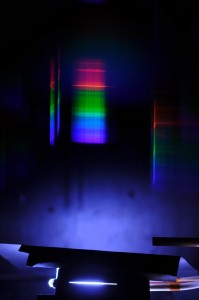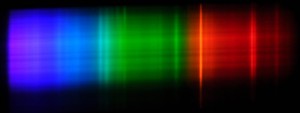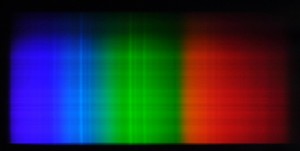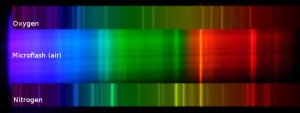The color of a light source can be unravelled into it’s principal components using a diffraction grating.
Each separate color (wavelength) is bent to a different position, resulting in a rainbow like image.
To best separate each color, a photo is taken of the light source behind a narrow slit. The resulting spectrum is an infite numbers of copies of that slit, spread out into a spectrum.

Setup, showing the slit below, with the spark gap behind it and the diffraction spectrum floating above in air
A Cokin P040 diffraction grating (240 lines per mm) was simply placed in front of a DSLR lense (5 Euros only, I was lucky, 40 Euros is a typical price), resulting in the following image:
Since air consists of 80% Nitrogen, 20% Oxygen and a small fraction of Argon, it’s spectrum should be a mix of the spectra of these atoms (some simulated spectra here). But when I look at this spectrum, I find it hard to match them. Also it lacks any hint of yellow tones, to me it is just RG&B.
For comparison I have also imaged my Nikon SB-600. I would expect a spectrum similar to Xenon, but also that does not really look like it.
For reference, these are the spectra from Joachim Koppen’s website (http://astro.u-strasbg.fr/~koppen/).
Finally an attempt to match the spectra of the air-gap flash to Oxygen and Nitrogen. It seems that the spectrum mainly consists of Nitrogen (which was to be expected). The simulated spectra of Oxygen en Nitrogen were blurred to match the resolution of the grating/slit photo.


